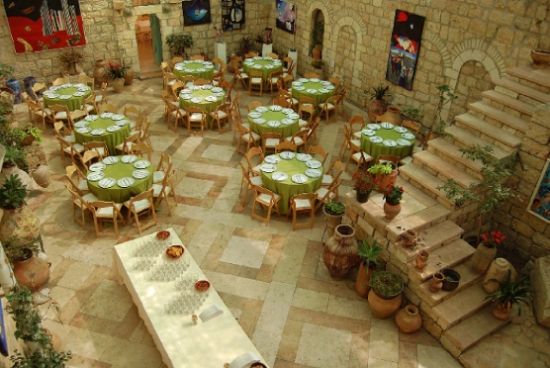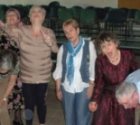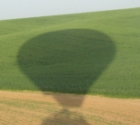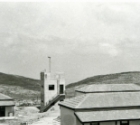
The courtyard at The Harp of David
After lunching with our friends at their home in the Abu Tor neighborhood, we decided it was a perfect day - crisp and clear - to walk to the Old City. We were surprised when we approached the Old City walls only 20 minutes later. Then there was a brief but steep climb up to Mt. Zion, with spectacular views of the Old City walls and the King David Hotel which is situated just across the adjacent Hinnom Valley.
After turning into a small street just outside the Old City walls we spotted an interesting doorway with a large courtyard beyond. Peering inside, we saw that this imposing structure was a restaurant, the Harp of David, with very interesting artwork. We were immediately invited to look around. The proprietor, Arik Pelzig, introduced himself and told us the fascinating story of the building and of his father, Perli Pelzig, who had immigrated to Jerusalem before WWII.
We were captivated by the canvases of Perli's girlfriend, Yanni Fritsma, now deceased. Yanni, born in Holland, was a very spiritual person who had dreamed about Perli long before she met him. Her spirituality is very evident in her naive paintings. The originals were for sale, but so were copies which were practically identical. They were photographs which could be reproduced in various sizes and printed on canvas. They were expensive, but much less so than the originals.
Perli Pelzig, whose family emigrated from Poland, was just a youngster when he began drawing life-size chalk figures of animals on the sidewalks in Germany. He soon became known as a 'wunderkind ' for his dazzling artistic capabilities. Pelzig continued to draw and paint during his early years. In 1937 he was invited to Hanover by an art professor to study, at no cost, in his art school. Pelzig, who was active in Zionist youth organizations in Germany, immigrated to Israel one year later when he was 21.
Drawing upon Jewish themes for his work, Pelzig was an artist, teacher and archeologist in Israel for many years. He traveled back and forth between Israel and the United States, unleashing his creativity by working on paintings, murals and stained-glass windows wherever he went. He was also an expert in restoring ancient mosaics such as the floor at the ancient Beit Alpha synagogue near Bet She'an.
Pelzig moved to the United States in 1956, where his endeavors included stained glass, mosaics, ceramics, tapestries, enamel work and sculpture. Examples of his work are located in Atlanta, New York, Miami, Los Angeles, Toronto and Nova Scotia. The Southern California Chapter of the American Institute of Architects awarded him two consecutive Triennial Fine Arts Awards. Pelzig returned to Israel for good in 1969, where he continued his creative activities, including a monumental sculpture at Yad Vashem. Among his favorite and most spiritual creations are the Harps of David: huge freestanding harps that create music from the wind.
The building exhibits examples of his late father's artwork and Arik's pots and ceramics. The restaurant's location is spectacular, with living quarters for Arik and his family underneath the restaurant. From the roof garden we had a wonderful view of the Old City walls, the Kidron Valley full of colorful churches and ancient tombs and the Judean Desert. In the distance were the majestic reddish mountains of Jordan.
Some of Perli's art is hung on the walls of a large dining room beyond the covered courtyard. One picture was a self-portrait painted in Germany in 1936. It was very dark, including an eclipse of the moon and bare, desolate trees. Perli explained to his son that "there was no light" in Germany at that time, which he replicated in his somber painting. In contrast to that painting was a lighthearted collage of 25 funny faces of Perli, bright in spirit despite its black/white color scheme. There were many old, unusual large pots made by Arab women by building up coils of clay, as well as. Arik’s versions which he throws on a wheel. They are even more expensive than those that are that are hundreds of years older.
The entire building has been extensively renovated by Arik, who, besides being an accomplished artist, is an excellent designer, artisan and renovator. There are beautiful ceramics throughout the building, some of which included facsimiles of Perli's or Yanni's artwork. One wall of the building is located right on the Green Line, the 1949 armistice line.
We were surprised to see a sales display of Antika kits which we have given as gifts to our nieces and nephews. Arik designed and produces these inventive broken pottery kits for budding archeologists. They come in 12 distinct designs and were featured at the Israel pavilion at Disney World's millennium exhibit. We've also seen them for sale at various museums.
Before we left the Harp of David, we enjoyed delicious herbal tea and a scrumptious gourmet version of Arab pastry. We had already checked out the business lunch menu, so we assured our host that we'd soon return.
We walked the few steps into the Old City via the Zion Gate, stopping only to see some of the gorgeous mosaic work in the churches at Mt. Zion. We then exited the Old City through the New Gate in the Christian Quarter. Our destination was the Notre Dame Guest House, which is a large hotel. It was built around 1880 as a French hospice, to house pilgrims to the Old City. Situated opposite the Old City walls, Notre Dame is a beautifully restored landmark, a center for Roman Catholic institutions and pilgrimage
groups. We checked out the impressive structure made of Jerusalem stone and found spacious public areas and an enormous dining room. What brought us to Notre Dame was the Pontifical Institute located there. Since 2006, the Notre Dame Center has displayed an extensive permanent exhibition about the Shroud of Turin which is an ancient linen cloth that bears the image of a crucified man who millions believe to be Jesus. This well-documented exhibit is of interest to both Christians and Jews. The Shroud looks genuine due to the wealth of scientific evidence and the lack of any other explanation for the impressions left on the cloth. We were impressed. The end of our intriguing day was dinner at an excellent Italian restaurant around the corner from Notre Dame. For sure, we are looking forward to discovering other hidden treasures in Jerusalem.

The art of Yanni Fritsma
 Let’s have a bit of Playback
Let’s have a bit of Playback-1372659501.jpg) Buying New Construction in Israel
Buying New Construction in Israel A lot of hot air - ballooning
A lot of hot air - ballooning-1450935317.jpg) Spending a Week in Tel Aviv
Spending a Week in Tel Aviv  Ma'ale Hachamisha
Ma'ale Hachamisha-1450857993.jpg) Jazz in a Pearl Garden
Jazz in a Pearl Garden  Steve Kramer
Steve Kramer